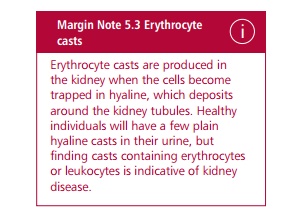Chapter: Biology of Disease: Disorders of the Immune System
Antiglomerular Basement Membrane Disease
ANTIGLOMERULAR BASEMENT MEMBRANE DISEASE
Antiglomerular basement membrane diseases are
characterized by autoantibodies to the glomerular basement membrane (antiGBM).
They include Goodpasture’s syndrome and Goodpasture’s disease. The former
disorder shows glomerulonephritis, pulmonary hemorrhage and the presence of
circulating antibodies to glomerular basement membrane; the latter is similar,
but without the lung involvement. Both diseases are now included under the more
general heading of antiGBM disease. Tissue damage is caused by antiGBM
antibodies binding to the glomerular basement membrane and activating
complement. Complement-mediated inflammation then ensues. The symptoms of
glomerulonephritis include proteinuria and hematuria and erythrocyte casts (Margin Note 5.3) are seen.

The binding of antibodies to alveolar membranes
causes hemoptysis, that is, the
coughing up of blood from the lungs and about 40% of patients experience chest
pain. Hemorrhaging from the lungs may eventually lead to respiratory failure.
There is some suggestion that the binding of antibodies to the alveolar
basement membranes is facilitated by exposure to organic solvents, which
increase the permeability of the alveolar capillaries. The incidence of antiGBM
disease is rare, of the order of 0.5 cases per million in the UK. Unlike mostautoimmune
disease, it shows a predominance in males, with younger males generally
presenting with both lung and kidney involvement.
Antiglomerular basement membrane disease can be
diagnosed from linear deposits of antiGBM antibodies, which can be visualized
by immunofluorescence on a kidney biopsy. An early diagnosis is essential and
treatment must be started immediately. Therapy involves removal of circulating
antibodies by plasmapheresis and the administration of immunosuppressive drugs
. The mortality rate for antiGBM disease is improving, and is currently at 10%,
although most patients develop end stage renal disease. In the past, the
disease was invariably fatal.
Related Topics